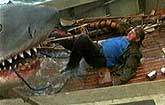S
| a mocking, ridiculing commentary on an economic, political, religious or social institution, ideology or belief, person (or group), policy, or human vice. | Examples: The Great Dictator (1940), Dr. Strangelove, Or How I Learned to Stop Worrying And Love the Bomb (1964), Brazil (1985) | |
| (1) the outline for a screenplay, or (2) a complete screenplay | ||
| usually a shot (or series of shots) that together comprise a single, complete and unified dramatic event, action, unit, or element of film narration, or block (segment) of storytelling within a film, much like a scene in a play; a scene normally occurs in one location and deals with one action; the end of a scene is often indicated by a change in time, action and/or location; see also shot and sequence. |
 Example: The classic love scene of John Wayne and Maureen O'Hara caught in a drenching rainstorm in a graveyard, and their rain-soaked embrace in The Quiet Man (1952) Example: The classic love scene of John Wayne and Maureen O'Hara caught in a drenching rainstorm in a graveyard, and their rain-soaked embrace in The Quiet Man (1952) |
|
| refers to the outdoor background in a set (represented by either a backdrop or a natural view). | ||
| usually refers to a character (or group of characters), usually subsidiary, whose appearance, actions and/or dialogue draws more attention than other actors in the same scene; similar to the term 'chewing up the scenery.' | Examples: Tim Curry as Darkness in Legend (1985); William Bendix as Jeff in The Glass Key (1942); John Gielgud as Hobson the butler in Arthur (1981) | |
| from the Yiddish expression for 'inferior' - refers to a forgettable, cheaply-made, low-budget, luridly-advertised B-film (or lower Z-film) with little or non-existent quality - often unintentionally hilarious; designed to take in profitable box-office in opening week; usually films found in the horror, comedy and science-fiction genres of the 50s and 60s. | Examples: Films from AIP (American International Pictures); also Robot Monster (1953) and The Giant Claw (1957), Sex Kittens Go to College (1960) | |
| the musical component of a movie's soundtrack, usually composed specifically for the film by a film composer; the background music in a film, usually specially composed for the film; may be orchestral, synthesized, or performed by a small group of musicians; also refers to the act of writing music for a film |
 Examples: Bernard Herrmann's memorable score with screeching violins for Hitchcock's Psycho (1960) or the score for The Wizard of Oz (1939) Examples: Bernard Herrmann's memorable score with screeching violins for Hitchcock's Psycho (1960) or the score for The Wizard of Oz (1939) |
|
| refers to the direction that characters or objects are moving in a film's scene or visual frame; common screen directions include "camera left" (movement to the left) or "camera right" (movement to the right); a neutral shot is a head-on shot of a subject with no evident screen direction; a jump-cut often indicates a change in screen direction | ||
| refers to a filmed audition in which an actor performs a particular role for a film production; casting often depends upon the photogenic (the projection of an attractive camera image) quality of the star. | ||
| the term for a promotional DVD (or video) version of a film that is sent to voters (and film critics) by the movie studios for their convenience during the awards season, before the movie is officially available to the public through video rental chains | ||
| the exhibition or display of a movie, typically at a cinema house/theatre; to screen (or unspool) a film means to show or project a film; types of screenings include a critical screening (a pre-release viewing for film critics), a pre-screening, or a focus-group screening (to test audience reactions to a film's rough cut); cinema is another term for a movie theatre. | ||
| a script or text for a film production written by a scripter or screenwriter(s) (or scribe), written (scribbled, scripted, or penned) in the prescribed form as a series of master scenes, with all the dialogue provided and the essential actions and character movements described; a script is written to be made into a movie; screenplays are often adaptations of other works; known archaically as a photoplay during the silent era. |
|
|
| the scripter who writes an original film screenplayor adapts another work into a film | ||
| a type of highly-verbal comedy prevalent in 1930's Hollywood, and typified by frenetic action, verbal wit and wisecracks (substituting or serving as a metaphoric euphemism for sex), a battle of the sexes with conflict that is ultimately resolved - all elements that serve as important plot points. | Examples: Capra's It Happened One Night (1934)and Hawks' Bringing Up Baby (1938) and His Girl Friday (1940); My Man Godfrey (1936), The Awful Truth (1937), Sturges' The Palm Beach Story (1942), and Cukor's The Philadelphia Story (1940). | |
(also shooting script) |
refers to the written text of a film - a blueprint for producing a film detailing the story, setting, dialogue, movements and gestures of actors, and the shape and sequence of all events in the film; in various forms, such as a screenplay, shooting script, breakdown script (a very detailed, day-to-day listing of all requirements for shooting, used mostly by crew), lined script, continuity script, or a spec script (written to studio specifications); a screenplay writer is known as a screenwriter, scripter, scribbler, scribe or penner; a last-minute script re-writer is known as a script doctor; a scenario is a script that includes camera and set direction as well as dialogue and cast direction; a shooting script is a detailed final version of the screenplay with the separate scenes arranged in proper sequence, and used by the cast during actual film-making. |
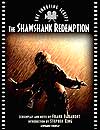 Example of shooting script, for The Shawshank Redemption (1994) Example of shooting script, for The Shawshank Redemption (1994) |
| in general terms, an actor who plays a subordinate or secondary role; aka second fiddle; in comedies, it refers to a performer who acts as a sidekick, foil or stooge (straight man) to a lead comedian | Examples: Dean Martin was a 'second banana' to Jerry Lewis when they were a comic duo; or Bud Abbott to Lou Costello; or Ralph Bellamy to Cary Grant in His Girl Friday (1940); also, Ward Bond as a secondary player in many westerns | |
| in larger film productions, this refers to the less important scenes (large crowd scenes, scenery, foreign location backgrounds, various inserts, etc.) that are filmed by a smaller, secondary or subordinate crew, usually headed by a second-unit director; contrast to principal photography | ||
| a section or episode of a film; a series of sequencesthat comprise a major section of the plot; segmentation of a film often helps to further analysis | ||
| an industry term meaning prerecorded videocassettes or DVDs priced lower, to encourage their sale rather than rental | ||
| a black-and-white image that has been converted to a sepia tone or color (a brownish gray to a dark olive brown) in order to enhance the dramatic effect and/or create an "antique" appearance |  Example: the black and white print for Cabin in the Sky (1943) was reprocessed as sepia-toned to create a more flattering skin tone for the actors; also an opening sequence (pictured) in Butch Cassidy and the Sundance Kid (1969) Example: the black and white print for Cabin in the Sky (1943) was reprocessed as sepia-toned to create a more flattering skin tone for the actors; also an opening sequence (pictured) in Butch Cassidy and the Sundance Kid (1969) |
|
| a cinematic work that presents the continuation of characters, settings, and/or events of a story in a previously-made or preceding movie; contrast to a prequel, follow-up, serial, series, spin-off or remake. | Examples: The Maltese Falcon (1941) followed by The Black Bird (1975); National Velvet (1944)followed by International Velvet (1978); A Man and a Woman (1966) followed by A Man and a Woman: 20 Years Later (1986); generally, sequels are inferior - with some exceptions, such as The Godfather, Part II (1974), Toy Story 2 (1999), The Empire Strikes Back (1980), X2: X-Men United (2003), etc. | |
| a scene, or connected series of related scenes that are edited together and comprise a single, unified event, setting, or story within a film's narrative; also refers to scenes that structurally fit together in the plot; sequence usually refers to a longer segment of film than a scene; sequences are often grouped into acts (like a three-act play); a sequence shot refers to a long, normally complicated shot with complex camera movements and actions; see also shot and scene. | Examples: the wedding sequence in The Godfather (1972), the drug-bust sequence in GoodFellas (1990) | |
| a multi-part, 'short-subject' film that was usually screened a chapter/episode per week at a film theatre; the predominant style of the serial was melodrama; often, each chapter or episode, continually presented in installments over several weeks, would conclude with an unresolved cliffhanger to ensure that audience would return the following week to discover the resolution; popular until the early 1950s; contrast with series and sequels. |  Example: The Perils of Pauline (1914). Example: The Perils of Pauline (1914). |
|
| a string or sequence of films with shared situations, characters or themes and related titles, but with little other inter-dependence, especially with respect to plot or significant character development. Usually presented without cliffhangers; the term also applies to feature films with more than one sequel; contrast with serials and sequels. | Examples of films made in series: The Thin Man (1934), Blondie (1938), Superman (1978), Rocky (1976), Star Trek - The Motion Picture (1979), the James Bond 007 films, and Planet of the Apes (1968). | |
| the environment (an exterior or interior locale) where the action takes place in a film; when used in contrast to location, it refers to an artificially-constructed time/place (a backdrop painting or a dusty Western street with a facade of storefronts); supervised by the film's art director; strike refers to the act of taking apart a set once filming has ended. |
 Example: the War Room set, production-designed for Dr. Strangelove, Or: How I Learned to Stop Worrying and Love the Bomb (1964). Example: the War Room set, production-designed for Dr. Strangelove, Or: How I Learned to Stop Worrying and Love the Bomb (1964). |
|
| usually a self-contained, elaborate scene or sequence that stands on its own (i.e., a helicopter chase, a dance number, a memorable fight, etc.), and serves as a key moment in the film; in terms of production, it may also refer to a scene with a large set |  Examples: the Death Star trench run in Star Wars (1977), the attack on a Vietnamese village by helicopters in Apocalypse Now (1979), the snake pit sequence in Raiders of the Lost Ark (1981), the musical duet-dance on a giant electronic keyboard in Big (1988), and the bullet-dodging sequence in The Matrix (1999). Examples: the Death Star trench run in Star Wars (1977), the attack on a Vietnamese village by helicopters in Apocalypse Now (1979), the snake pit sequence in Raiders of the Lost Ark (1981), the musical duet-dance on a giant electronic keyboard in Big (1988), and the bullet-dodging sequence in The Matrix (1999). |
|
| the time (time period) and place in which the film's story occurs, including all of the other additional factors, including climate (season), landscape, people, social structures and economic factors, customs, moral attitudes, and codes of behavior; aka locale. | ||
| the place or position where the director and the director of photography put the camera (and lighting) when shooting a scene; a scene is usually shot with multiple setups and with multiple takes from each setup; aka angle. | ||
(screenplay) |
in screenplay terms, set-up refers to the first act in which the characters, situation, and the setting are established. | Example: the 'first act' of The Wizard of Oz (1939)before the Technicolor sequences in the Land of Oz |
| a humorous, light-hearted film with an improbable plot about sexual relationships and extra-marital affairs, with various pairings between numerous characters, often characterized by slamming doors; aka sex farce or bedroom farce. | Examples: Woody Allen's A Midsummer Night's Sex Comedy (1982), Hal Ashby's Shampoo (1976), the Italian film Casanova 70 (1965). | |
| refers to non-pornographic, non-explicit, soft-core films that feature sexual themes or explicit sexual material and nudity often in an apparently crude, immature, leering way; these films exploited the concept of sex without violating long-standing cultural and legal taboos against showing it all on the screen; often with lurid titles; aka skin flick | 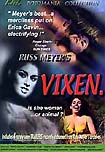 Examples: the films of Russ Meyers, such as Faster, Pussycat! Kill! Kill! (1966), Vixen (1968). Examples: the films of Russ Meyers, such as Faster, Pussycat! Kill! Kill! (1966), Vixen (1968). |
|
(or story) |
a long-winded, overly convoluted, often irrelevant, protracted or complicated plot, tale or storyline, that often pointlessly or meaninglessly ends up (sometimes after an extensive quest or search) with no resolution at all or with an anti-climax | Example: The 'contract' scene in the Marx Brothers' A Night at the Opera (1935), The Wizard of Oz (1939), Monty Python and the Holy Grail (1975), Raiders of the Lost Ark (1981), The Usual Suspects (1995), U Turn (1997), The Big Lebowski (1998), Burn After Reading (2008) |
| the process of filming or photographing any aspect of a motion picture with a camera; the plan for a shoot is termed a shooting schedule. |
 Example: a 'behind-the-scenes' look at the shooting of the "Yellow Brick Road" scene in The Wizard of Oz (1939) Example: a 'behind-the-scenes' look at the shooting of the "Yellow Brick Road" scene in The Wizard of Oz (1939) |
|
(short or short films) |
a film that is shorter than around 30 or 45 minutes, and definitely less than 60 minutes; in the silent film era, most films were shorts, such as those shown in nickelodeons; then, during the early film era, the price of a movie ticket included not only the weekly feature but also "selected short subjects," as they were usually billed; contrast to feature films. | 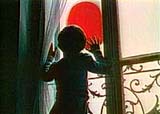 Examples: the 1930s talkie shorts of Our Gangor The Little Rascalsfrom Hal Roach Studios; the Pete Smith Specialties short subject films (from the mid-1930s to mid-1950s); MGM's crime dramas and investigative exposes - Crime Does Not Pay shorts (from the mid-1930s to mid-1940s); Warners' popular Joe McDoakes series in the 1940s and 1950s; Robert Benchley's series of comedy shorts; MGM's one-reel Dogville comedies; also the Oscar-winning childhood fantasy short, The Red Balloon (1956, Fr.) (pictured) Examples: the 1930s talkie shorts of Our Gangor The Little Rascalsfrom Hal Roach Studios; the Pete Smith Specialties short subject films (from the mid-1930s to mid-1950s); MGM's crime dramas and investigative exposes - Crime Does Not Pay shorts (from the mid-1930s to mid-1940s); Warners' popular Joe McDoakes series in the 1940s and 1950s; Robert Benchley's series of comedy shorts; MGM's one-reel Dogville comedies; also the Oscar-winning childhood fantasy short, The Red Balloon (1956, Fr.) (pictured) |
|
the basic building block or unit of film narrative; refers to a single, constant take made by a motion picture camera uninterrupted by editing, interruptions or cuts, in which a length of film is exposed by turning the camera on, recording, and then turning the camera off; it can also refer to a single film frame (such as a still image); a follow-shot is when the camera moves to follow the action; a pull-back shot refers to a tracking shot or zoom that moves back from the subject to reveal the context of the scene; see also scene and sequence; shot analysis refers to the examination of individual shots; a one-shot, a two-shot, and a three-shot refers to common names for shooting just one, two, or three people in a shot |
 Example of a single film frame or shot, of Fay Wray rehearsing the moment of meeting Kong, from King Kong (1933). Example of a single film frame or shot, of Fay Wray rehearsing the moment of meeting Kong, from King Kong (1933). |
|
| a shot, scene, and sequence together make up the larger dramatic narrative of film; scenes are composed of shots, sequences are composed of scenes, and films are composed of sequences. | ||
| the list distributed and used by a film crew of all the shots to be filmed during the day | ||
| refers to the length of time a single frame is exposed | ||
| aka visual gag; an image that conveys humor visually, usually non-verbally; often used in silent film comedy, or in films with very little dialogue. |  Example: all silent film comedies, Jacques Tati's Playtime (1967), the animated film The Triplets of Belleville (2003), or the scene of Cameron Diaz with semen as her hair-gel in There's Something About Mary (1998) (pictured), or numerous examples from James Bond films, such as Moonraker (1979) (pictured) - Example: all silent film comedies, Jacques Tati's Playtime (1967), the animated film The Triplets of Belleville (2003), or the scene of Cameron Diaz with semen as her hair-gel in There's Something About Mary (1998) (pictured), or numerous examples from James Bond films, such as Moonraker (1979) (pictured) - 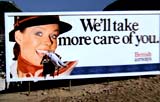 the death of a henchman propelled head-first into a billboard advertising British Airways claiming: "We'll Take More Care of You" - his head appeared consumed by the flight attendant's mouth the death of a henchman propelled head-first into a billboard advertising British Airways claiming: "We'll Take More Care of You" - his head appeared consumed by the flight attendant's mouth |
|
(or silents) |
the term for motion pictures without sound (spoken dialogue or synchronized soundtrack), although they were often accompanied by live commentary, piano-music, sound effects, and/or orchestration; the period from about 1895 to 1927 (when "talkies" were introduced); contrast with talkies. | 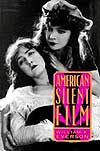 |
| aka "magic bullet" - a solution that completely solves the complicated dramatic problem within a film; the term was derived from European folklore in which only a silver bullet could kill a werewolf. | Example: the silver bullet was used in The Lone Ranger Show (on radio and TV, and later on film) as a symbol of the Lone Ranger's presence to solve various problems. | |
| refers to a film element, used by the film-maker to indicate a character's or object's relative strength compared to other things or persons |  Example: in Citizen Kane (1941), Kane looks massive compared to wife Susan working on a puzzle and dwarfed in size by a gigantic fireplace Example: in Citizen Kane (1941), Kane looks massive compared to wife Susan working on a puzzle and dwarfed in size by a gigantic fireplace |
|
| the optical printing effect of skipping or cutting out certain frames of the original scene to speed up the action | ||
| a broad form of comedy in which the humor comes from physical acts or pantomime, frequently harmless violence and pratfalls intended to produce laughter. The name was derived from a device called a slapstick, two boards that slapped together with a loud crack when used to strike something or someone; prevalent during the silent era and in early talkies, with its primary motif being pie-throwing. |
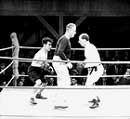 Examples: Keystone Kops, Charlie Chaplin (here in the extended boxing sequence in City Lights (1931)), Laurel and Hardy, Buster Keaton, the Three Stooges, and more recently, Jerry Lewis and Jim Carrey. Examples: Keystone Kops, Charlie Chaplin (here in the extended boxing sequence in City Lights (1931)), Laurel and Hardy, Buster Keaton, the Three Stooges, and more recently, Jerry Lewis and Jim Carrey. |
|
| usually a cheaply-made sub-genre film (usually in the horror genre) designed for the teenage audience (teen movie), deliberately made to contain gory, blood-splattering, explicit deaths without any build-up, style or suspense, often committed by an unstoppable serial killer, with a sharp bladed weapon; most slasher films are created to generate sequels and repetitive boredom; aka splatter films; see also trash film, grindhouse film, schlock film, B-film and Z-film | 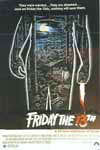 Examples: Three of the best known, classic slasher films that were commercially successful include Hitchcock's Psycho (1960), Carpenter's Halloween (1978), and Wes Craven's A Nightmare on Elm Street (1984); also the films of Mario Bava and Dario Argento (i.e. Deep Red (1975)), The Texas Chainsaw Massacre (1974), Lucio Fulci's Zombie (1979), Sleepaway Camp (1983), the Friday the 13thfranchise; also in the parodies beginning with Scream (1996). Examples: Three of the best known, classic slasher films that were commercially successful include Hitchcock's Psycho (1960), Carpenter's Halloween (1978), and Wes Craven's A Nightmare on Elm Street (1984); also the films of Mario Bava and Dario Argento (i.e. Deep Red (1975)), The Texas Chainsaw Massacre (1974), Lucio Fulci's Zombie (1979), Sleepaway Camp (1983), the Friday the 13thfranchise; also in the parodies beginning with Scream (1996). |
|
| refers to the digital board held in front of the camera that identifies shot number, director, camera-person, studio and title; the slate has the clap sticks on top and the scene number, take and production name or title usually written on it, and the person operating the slate will say "mark" and clap the sticks for picture and sound sync purposes; originally the data was written with chalk on a slate board; the footageof the slate at the beginning of each shot or take is used in the laboratory and editing room to identify the shot; see also clapboard |
 |
|
| a movie that is released with little publicity or pre-release buzz, often directed by and starring relatively unknown people, that eventually becomes popular (as a cult film) or financially successful beyond expectations, usually due to positive word-of-mouth; the term is sometimes used incorrectly to describe unpopular movies that the critics love | 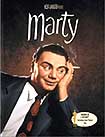 Examples: Marty (1955), and My Big Fat Greek Wedding (2002) Examples: Marty (1955), and My Big Fat Greek Wedding (2002) |
|
(or slo-motion) |
refers to an effect resulting from running film through a camera at faster-than-normal speed (shooting faster than 24 frames per second), and then projecting it at standard speed; if a camera runs at 60 frames per second, and captures a one second-long event, a 24-frame playback will slow that event to two and a half seconds long; overcrank(ing)means to speed up the camera, thereby making the action appear slower when projected - the term dates back to the old days of physically hand-cranking film through a camera; this filmic technique is usually employed to fully capture a 'moment in time' or to produce a dramatic (or romantic feeling); contrast to fast-motion (or accelerated motion, achieved by undercranking) or time compression | Example: often used in sports films in which the climactic winning catch or play is run in slow-motion |
(or shock cut) |
a cinematic term that refers to an abrupt, jarring and unexpected change or transition in the scene or film's image (and the audio) to another scene or image, in order to surprise the viewing audience; see also transition | Example: often used in murder scenes or when a character is suddenly awakened from a nightmare; it also may be evidenced in a sudden cut to a black screen |
| any piece of projected footage during (usually prior to) a motion picture feature presentation that is not a trailer or film presentation, i.e., announcements and theatre promos for the concession stand, courtesy requests and prohibitions (such as turning off cell phones, curbing loud talking, etc.) | ||
| during nominations or awards proceedings, when a prominent, leading, or favored performer/director/crew member or film is inexplicably excluded or denied an award or nomination | Examples: See Academy Awards Mistakes and Omissions | |
| a cinematographic effect in which a filter, vaseline or gauze-like substance placed over the camera lens reduces the clarity or sharpness of focus, blurs the image, and produces a diffused, hazy light; the visual effect can also be created by simply shooting out-of-focus; it is often used to enhance romantic or dreamy scenes, or to remove wrinkle lines from an actor's face |  Example: often used in the 1930s; also in the love scene at the French plantation in Apocalypse Now Redux (1979 and 2001) Example: often used in the 1930s; also in the love scene at the French plantation in Apocalypse Now Redux (1979 and 2001) |
|
| a dramatic monologue delivered by a single actor with no one else onstage; sometimes expressed as a 'thinking aloud' dialogue of inner reflections; delivered by a character to him or herself, or directly to the audience; contrast to an aside. | Examples: See this site's Best Speeches and Monologues section. | |
| the audio portion of a film including dialogue, music, and effects; sound effects refers to all created sounds except dialogue or music | ||
(or stage) |
a large, soundproof area/room in a studio used in film production, where elaborate sets may be constructed, to allow film-makers greater control over climate, lighting, and sound, security, and spectators. |
 Example: The "You Were Meant For Me" scene deliberately shot on an empty sound stage, in Singin' in Rain (1951). Example: The "You Were Meant For Me" scene deliberately shot on an empty sound stage, in Singin' in Rain (1951). |
| technically, this term refers to the audio component of a movie, including the dialogue, musical score, narration, and sound effects, that accompany the visual components. Popularly, it refers to a collection of songs heard during the movie, and often sold as an album. | 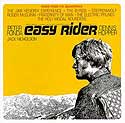 Example: Soundtrack from Easy Rider (1969) Example: Soundtrack from Easy Rider (1969) |
|
| a western, low-budget B-movie filmed in Italy (or Spain) during the 60s, usually characterized by low production values, sparse dialogue. |  Examples: Sergio Leone's westerns, starring Clint Eastwood as an amoral drifter - the poncho-clad gunslinger Blondie. Examples: Sergio Leone's westerns, starring Clint Eastwood as an amoral drifter - the poncho-clad gunslinger Blondie. |
|
| an unsolicited or non-commissioned ("speculative") screenplay sent to a studio by a screenwriter for consideration (hoping that it will possibly be 'optioned' or purchased); aka speculative screenplay | ||
(or F/X, SFX, SPFX, or EFX) |
a broad, wide-ranging term used by the film industry meaning to create fantastic visual and audio illusions that cannot be accomplished by normal means, such as travel into space. Many visual (photographic) or mechanical (physical) filmic techniques or processes are used to produce special illusionary effects, such as optical and digital effects, CGI, in-camera effects, the use of miniatures/models, mattes, rear-camera projections, stop-motion animation, bluescreens, full-scale mockups, pyrotechnics (squibs (miniature explosions, i.e. a gunshot)), stunt men, animatronics (electronic puppets), rain/snow/wind machines, etc.; F/X are coordinated by the visual effects and the special effects supervisors; known negatively as trick photography; see also visual effects - a sub-category of special effects. See this site's Milestones in Special/Visual Effects in Film History. |  King Kong (1933) and the use of models  Hitchcock's The Birds (1963)  The Incredible Shrinking Man (1957) |
| refers to a derivative work (film or TV), either a sequel or a prequel which includes characters from the previous original product; contrast to a prequel, follow-up, serial, series, sequel or remake | Examples: The Scorpion King (2002) was a spin-off of The Mummy Returns (1999) with the character of the Scorpion King (Dwayne Johnson); or Alien vs. Predator (2004) - an obvious spin-off of previous hits; Laverne & Shirley was a spin-off of the TV show Happy Days | |
| an editing technique used to ease the transition from one scene to another, in which the audio starts before (or after) the picture cut; aka L-cut or J-cut | ||
| in the silent era, refers to two different short-subject films (each too brief for a separate screening) that were joined together on one reel for movie-house exhibition | ||
| the combination of two actions filmed separately by copying them onto the same negative and having them appear side-by-side within a single frame (without overlapping); a slight variation on split-screen is termed multiple image (different images are set alongside each other within a single frame); split-screen is usually intended to signify simultaneous action; also see bluescreen and matte shot |   Examples include: phone conversations between Rock Hudson and Doris Day in Pillow Talk (1959) (shown above); Woodstock (1970), The Thomas Crown Affair (1968), Napoleon (1927), and The Grifters (1990) (shown above); also in scenes between an actor and a wild animal on different sides of the frame, used in Bringing Up Baby (1938), Forbidden Planet (1956), and Krull (1983). |
|
| information about the plot or ending of a film that may damage or impair the enjoyment of the film if known ahead of time; usually, critics or reviewers warn readers with a 'spoiler alert', or avoid revealing spoilers altogether. See Greatest Plot Twists and Spoilers |
|
|
| usually a comedic film that pays tribute to an earlier film in a humorous way. |
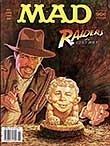 Raiders of the Lost Ark (1981) was spoofed as 'Raiders of a Lost Art' in MAD Magazine (Jan '82) |
|
| a substitute person who is physically similar (in size and appearance) to an actor and who takes the actor's place during often lengthy preparation of a scene (the taking of light meter readings, camera setup, light adjustment, etc.) but not during filming. Not to be confused with a stunt double or a body double. | ||
| the name given to famous, talented, and popular actors or celebrities, often in lead character roles, who can draw an audience to a film with their photogenic appearance, inspirational acting, or some other quality. Historically, a starlet (or ingenue) was an attractive actress promoted by a film studio in a small role as an up-and-coming star during the 40s and the 50s; also used in the term star quality and star system |
 Example: Mel Gibson, director and star of Braveheart (1995) Example: Mel Gibson, director and star of Braveheart (1995) |
|
| refers to the way in which studios "groomed" stars under contract, and sought star vehicles for them; studios served as protectorates for their stars | ||
| a film expressly made to show off the talents of a performer, with all other aspects almost secondary; compare with tour de force | Examples: Twentieth Century (1934) with John Barrymore; Victor/Victoria (1982) with Julie Andrews (whose husband Blake Edwards wrote and directed) | |
| an unmoving or immobile camera shot that is stationary, due to the use of a tripod | ||
| a hand-held camera technique using a stabilizing Steadicam (introduced in the late 70s), developed by inventor Garrett Brown, with a special, mechanical harness that allows the camera operator to take relatively smooth and steady shots, though hand-held, while moving along with the action; the resulting images are comparable to normal tracking shots on a wheeled dolly |
Examples: earliest use in Bound for Glory (1976), some uses also in Rocky (1976), in the lengthy tracking shots down the corridors of the Overlook Hotel in Kubrick's The Shining (1980), and in Return of the Jedi (1983); also the over 5-minute uncut Steadicam shot along the beach at Dunkirk in Atonement (2007) |
|
(or scene-stealing) |
usually refers to a supporting actor/actress attracting attention from the lead actor or actress to whom the center of interest legitimately belongs; see also 'tour de force' performance | |
| the act of portraying a particular character (or group) with a formulaic, conforming, exaggerated, and oversimplified representation, usually offensive and distorted | Example: in Breakfast at Tiffany's (1961), the portrayal of Audrey Hepburn's upstairs neighbor, Mr. Yunioshi (Mickey Rooney) in an exaggerated way: with buck-teeth, a pronounced accent, and comic ineptness - all conveying a degrading and stereotypical view of Japanese or Asian men; this scene was also replayed in Dragon: The Bruce Lee Story (1992) | |
| refers to a single, static image, either (1) a frame still (possibly enlarged) from a finished film, (2) a production still taken from an unfinished film, or (3) a publicity shot (of an actor or scene); aka photogram. |  Example: a publicity still of the major cast members of The Wizard of Oz (1939) and  a still taken from To Kill a Mockingbird (1962) |
|
| a surprising, last-minute bit of dialogue (or footage) that appears after the end (or closing) credits |  Example: title character Ferris (Matthew Broderick) breaks the fourth wall and tells the audience: "You're still here? It's over! Go home. Go!" in Ferris Bueller's Day Off (1986); or the end of The Muppet Movie (1979) when Animal yells at the audience: "Go home! Go home! Bye-Bye." Example: title character Ferris (Matthew Broderick) breaks the fourth wall and tells the audience: "You're still here? It's over! Go home. Go!" in Ferris Bueller's Day Off (1986); or the end of The Muppet Movie (1979) when Animal yells at the audience: "Go home! Go home! Bye-Bye." |
|
| a minor character whose actions are completely predictable, stereotypical, or standard for his/her job or profession; similarly, a stock situation is a basic, recognizable plot situation (e.g., a lover hiding in the closet, twins mistaken for each other, etc.). | Examples: the wily servant, the braggart soldier, the innocent virgin, a drunken husband, etc. | |
(or stock/library shot) |
refers to previously-shot or recorded footage or film of common elements or scenes, such as canyons or deserts in the American West, or travelogue shots (e.g., skylines, airplane takeoffs/landings, famous places, etc.), or historical events footage, that are kept in a film archive or library and used by editors to fill in portions of a movie in different film productions, thereby saving the time of reshooting similar scenes over and over; a stock shot refers to an unimaginative or commonplace shot that looks like it could be stock footage | Example: The DC-3 flying over the Himalayas when Indy leaves Nepal in Raiders of the Lost Ark (1981)was lifted from Lost Horizon (1973); many films use historical footage of the bombing of Pearl Harbor, street scenes in NYC, or destruction sequences |
(animation) |
a special-effects animation technique where objects, such as solid 3-D puppets, figures, or models are shot one frame at a time and moved or repositioned slightly between each frame, giving the illusion of lifelike motion. Stop-motion was one of the earliest special-effects techniques for science-fiction films, now replaced by CGI and animatronics; aka stop-frame motion |  Example: the stop motion animation in the first great monster movie, King Kong (1933); also in the landmark films by Ray Harryhausen such as Jason and the Argonauts (1963); The Adventures of Mark Twain (1985), The Sandman (1991), Wallace & Gromit: Curse of the Were-Rabbit (2005) and Corpse Bride (2005) Example: the stop motion animation in the first great monster movie, King Kong (1933); also in the landmark films by Ray Harryhausen such as Jason and the Argonauts (1963); The Adventures of Mark Twain (1985), The Sandman (1991), Wallace & Gromit: Curse of the Were-Rabbit (2005) and Corpse Bride (2005) |
| the events that appear in a film and what we can infer from these events; aka narrative or plot | ||
| a sequential series of illustrations, stills, rough sketches and/or captions (sometimes resembling a comic or cartoon strip) of events, as seen through the camera lens, that outline the various shots, indicate camera angles, blocking of actors, and the size of the frame; they provide a synopsis for a proposed film story (or for a complex scene) with its action and characters; the storyboards are displayed in sequence for the purpose of visually mapping out and crafting the various shot divisions and indicating camera movements in an animated or live-action film; a blank storyboard is a piece of paper with rectangles drawn on it to represent the camera frame (for each successive shot); a sophisticated type of preview-storyboard (often shot and edited on video, with a soundtrack) is termed an animatic |
|
|
| an actor/actress who serves as a stooge for a comedian (or funnyman), usually by adopting a serious stance or reaction to the comic partner; the straight man often feeds lines to the other irreverent comedian - who replies with witty comments; aka second banana or foil |  Examples: Margaret Dumont in numerous Marx Brothers films (pictured here in the opening scene with Groucho in A Night at the Opera (1935)); also Bud Abbott to Lou Costello. Examples: Margaret Dumont in numerous Marx Brothers films (pictured here in the opening scene with Groucho in A Night at the Opera (1935)); also Bud Abbott to Lou Costello. |
|
| (1) the for-profit companies that specialize in developing, financing and distributing most American commercial films; (2) also refers to the actual site for a film production, with physical sets, stages, offices, backlots (located on the outdoor grounds of a film studio and used for filming exteriors), etc; see also majors and independents, and mogul. |
 Example: An archival view of the front entrance to Paramount Pictures film studio. Example: An archival view of the front entrance to Paramount Pictures film studio. |
|
| the head or chairperson of a film studio who has the final authority for each film project (gives the green light - or authorization go-ahead), and oversees the many departments (financial, legal, marketing, advertising, distribution, etc.); also called the topper; in Hollywood's Golden Age, the chief was called a mogul |  Example: studio chief (mogul) Louis B. Mayer of MGM Example: studio chief (mogul) Louis B. Mayer of MGM |
|
| refers to the all-powerful control the monopolistic film studios had over all aspects of assembly-line filmmaking and film production from the 1920s until the late 1950s, when chiefs - moguls (Mayer, Selznick and Zukor) ruled; tactics included the ownership of property, control of publicity and marketing, and iron-clad contracts with star-actors, directors, composers, cameramen, costume designers, writers, and producers. | ||
| a stunt performer(s) (aka stunts) that take the place of an actor when the scene calls for a dangerous or risky action (car crash, fight, window jump, etc.); doubles usually have the same build or appearance as the star; also called stunt performer, stuntmanor stuntwoman; not to be confused with a stand-inor a body double; stunts are supervised, conducted and planned by a stunt coordinator | 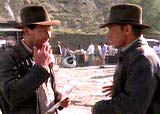 Example: Harrison Ford with his stunt double Vic Armstrong on the set ofIndiana Jones and the Last Crusade (1989) Example: Harrison Ford with his stunt double Vic Armstrong on the set ofIndiana Jones and the Last Crusade (1989) |
|
| a term that refers to the artificial exaggeration or elimination of details in order to deliberately create an effect - in other words, to make (or interpret) a person, a face, a tree, a figure, or something as 'grotesque,' 'disturbing,' or 'overbright' as opposed to realistic or naturalistic. | Examples: James Whale's Bride of Frankenstein (1935), stylized film noir classics T-Men (1947) and He Walked By Night (1948), Joseph Mankiewicz's Guys and Dolls (1955), or Fellini's 8 1/2 (1963) | |
point-of-view (POV) |
a film in which the narrator has a limited point-of-view regarding the characters, events, action, places, thoughts, conversations, etc.; a subjective camera is a style of filming that allows the viewer to look at events from the POV of either a character or the author, when the camera position is close to the line of sight of the character; contrast to omniscient point-of-view | 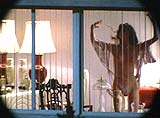 Examples: Many of Hitchcock's films featured a subjective POV (ie. Scottie Ferguson's (James Stewart) distorting, swirling POV in Vertigo (1958) or Rear Window (1954)), or in Brian DePalma's Body Double (1984) (pictured); the many POV shots in 2001: A Space Odyssey (1968) (from computer HAL 9000's POV as well as Dave Bowman's (Keir Dullea)), and John Carpenter's Halloween (1978)) featured POV shots from Michael Myers and Laurie Strode (Jamie Lee Curtis) Examples: Many of Hitchcock's films featured a subjective POV (ie. Scottie Ferguson's (James Stewart) distorting, swirling POV in Vertigo (1958) or Rear Window (1954)), or in Brian DePalma's Body Double (1984) (pictured); the many POV shots in 2001: A Space Odyssey (1968) (from computer HAL 9000's POV as well as Dave Bowman's (Keir Dullea)), and John Carpenter's Halloween (1978)) featured POV shots from Michael Myers and Laurie Strode (Jamie Lee Curtis) |
| a secondary, subordinate, or auxiliary plotline, often complementary but independent from the main plot(the A story), and often involving supporting characters; not the same as multiple plotlines; aka the B story or C story | Example: one of the film's many plotlines - 'video peeping tom' Ricky Fitts (Wes Bentley), the abused teenaged son of repressed and Nazi-worshipping Col. Fitts (Chris Cooper), the next door neighbor, and how Lester Burnham (Kevin Spacey) was mistaken for being gay in American Beauty (1999)by Col. Fitts. | |
| the deeper and usually unexpressed "real" meanings of a character's spoken lines or actions - if the viewer can 'read between the lines'. | ||
| refers to the printed line(s) of text superimposed and displayed at the bottom of the screen frame, often used to translate a foreign-language phrase, or to describe a time/place; also the text translating an entire foreign language film (that hasn't been dubbed); often termed caption |
 Example: Subtitle in Close Encounters of the Third Kind (1977). Example: Subtitle in Close Encounters of the Third Kind (1977). |
|
| short for the influential Sundance Film Festival, known for the exhibition and screening of the best of independent films each year in Utah; also see (film) festival | ||
(or superimposition) |
an optical printing process that places or 'exposes' one image on top of another on the same piece of filmstock, such as inserted credits and titles at the beginning of a film; sometimes composed as a double exposure |
 Example: in Hitchcock's Vertigo (1958) during Scottie's nightmare sequence, his face is superimposed over a drawing, Example: in Hitchcock's Vertigo (1958) during Scottie's nightmare sequence, his face is superimposed over a drawing,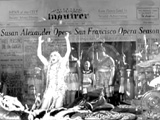 or in Citizen Kane (1941) the superimposition and exposure of two images: reviews in the SF Newspaper and Susan Alexander's performance. or in Citizen Kane (1941) the superimposition and exposure of two images: reviews in the SF Newspaper and Susan Alexander's performance. |
(or players, characters) |
characters seen less frequently than the lead rolecharacters, but still in important, secondary roles; often termed a featured player or feature player; well-known guest stars often play brief supporting roles in a film; character actors are usually in supporting roles | |
| a term applied to a film, signifying a distorted or fantastic dream state, a nightmarish or hallucinogenic world, or a subconscious thought or death experience; often expressed by a random, non-sequential juxtaposition of images that go beyond realism | 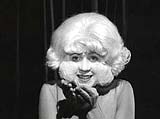 Examples: the eerie Salvador Dali dream sequence in Hitchcock's Spellbound (1945), and David Lynch's Eraserhead (1977)(pictured). Examples: the eerie Salvador Dali dream sequence in Hitchcock's Spellbound (1945), and David Lynch's Eraserhead (1977)(pictured). |
|
| another term for a suspense/thriller film | Examples: Most of Alfred Hitchcock's films | |
| usually refers to adventure films with an heroic, athletic, sword-wielding character | Example: Errol Flynn's swashbucklers, such as Captain Blood (1935). | |
| a term for a movie, usually a Roman or Biblical epic, characterized by the weapons (swords) and footwear (sandals) of the period |  Examples: the many Victor Mature films, such as Samson and Delilah (1948), The Robe (1953), and Demetrius and the Gladiators (1954). Examples: the many Victor Mature films, such as Samson and Delilah (1948), The Robe (1953), and Demetrius and the Gladiators (1954). |
|
| a term for the class of fantasy movies characterized by the presence of wizards and warriors, magic and sword fighting |
 Example: Conan the Barbarian (1982). Example: Conan the Barbarian (1982). |
|
| an object in a film that stands for an idea, or that has a second level of meaning to it, e.g., a window or train=freedom, a rose=beauty, a cross-roads=a decision point, etc.; the more a symbol is repeated, the greater its significance | Example: in M. Night Shyamalan's The Sixth Sense (1999) - the visual clue or symbol of cold air indicating the presence of ghost spirits | |
| within a film when two or more distinct plotlines 'mirror' each other or develop variations on the film's theme or plot; aka mirroring | Examples: David Lynch's Lost Highway (1997), and Woody Allen's Crimes and Misdemeanors (1989) | |
| refers to sound whose source can be seen in the image's frame, or whose source can be understood from the context of the image | ||
źródło:www.filmsite.org

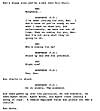
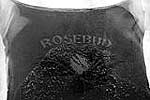 Examples: "Darth Vader is Luke's father," "Rosebud" is the name of the sled in
Examples: "Darth Vader is Luke's father," "Rosebud" is the name of the sled in  Examples:
Examples: 

